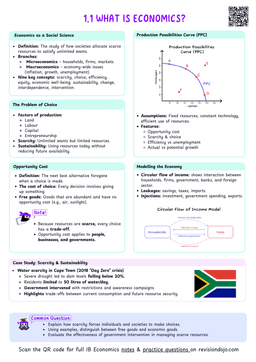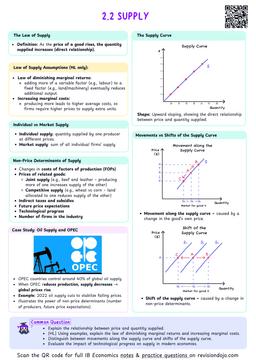A fundamental issue in Economics is determining the most efficient way to distribute limited resources. A production possibility curve (PPC) illustrates the possible production combinations of two different goods or services using those resources.
Production possibilities curve (PPC)
Curve that illustrates all possible combinations of two goods that an economy can produce at maximum output when using all available resources and current technology efficiently.

Producing along the PPC
- The PPC above shows the maximum number of houses (on the horizontal axis) and vehicles (on the vertical axis) that can be made, using all the existing resources in the economy.
- An economy can choose to produce a maximum combination of goods represented by any point in its PPC curve.
- Points A, B, C, and D (along with any other point on the PPC) can be reached without needing additional resources than those available in the economy.
- However, all the available resources must used as efficiently as possible for the economy to produce at any point along its PPC (the production possibilities are maximised).
If Figure 1's economy is utilising all of its factors of production as efficiently as possible, it can choose to whether to produce at point B (around 240 burgers and 160 laptops), at point C (around 175 burgers and 240 laptops), or at any other point alongs its PPC.
Producing inside the PPC
- Figure 1's economy can produce, if all its current factors of production are used as efficiently as possible, a maximum combination of goods at any point along its PPC curve.
- Therefore, if the economy produces a combination of goods at any point inside its PPC curve (like point F), that means that either:
- Not all the economy's factors of production are utilised.
- Not all the economy's factors of production are utilised efficiently: there is losses in the production possibilities due to inefficiencies.
- For Figure 1's economy to move from point F to any point closer (or at) its PPC curve, it must either utilise more of its currently available factors of production or improve its production efficiency.
In real life, most economies actually produce inside their PPCs. This is due to the fact that there are always inefficiencies in production process.
Not producing along an economy's PPC tends to be result of efficiency losses rather than not utilising all the available factors of production.
Producing outside the PPC
- Producing at point E (or any other point beyond the PPC) is unattainable with the economy's existing resources, because it means that point E lies beyond the production possibilities of the economy.
- The economy simply does not have the resources (factors of production) to produce 250 burgers and 250 laptops. Producing that quantity of burgers and laptops simultaneously would require additional or improved resources.
- In order to produce at any point outside its PPC curve (like point E), the economy must access extra or better resources than those currently available.
Assumptions of the PPC model
The PPC model simplifies the complexities of an economy by making several key assumptions:
- Two Goods: The economy produces only two goods or services (e.g., consumer goods and capital goods), simplifying the analysis.
- Fixed Resources: The quantity and quality of resources (land, labor, capital, and entrepreneurship) are constant.
- Fixed Technology: The level of technology remains unchanged during the analysis period.
- Full Employment and Efficiency: All resources are used fully and efficiently, meaning there is no waste or unemployment.
While these assumptions simplify the model, they do not perfectly reflect the complexities of real-world economies.
Increasing versus constant opportunity costs in a PPC model
In the previous section the concept of opportunity costs was introduced as the value of the next best alternative that must be sacrificed when making a choice between different production options.
NoteIn the context of the Production Possibilities Curve (PPC), opportunity cost represents the amount of one good that must be forgone to produce more of another good.
A PPC curve can showcase two types of opportunity costs between two goods an economy is producing:
- Increasing opportunity costs.
- Constant opportunity costs.
Increasing Opportunity Costs
Increasing opportunity costs occur when producing additional units of one good requires increasingly larger sacrifices of the other good.
- In Figure 1, if the economy is producing at point B (around 240 burgers and 160 laptops), it may choose to produce at point A instead (260 burgers and 50 laptops). Moving to point A:
- The economy is sacrificing 110 laptops (from 160 to 50) only to increase the production of burgers by 20).
- The opportunity costs of those 110 laptops is really low. By choosing to produce those 110 laptops, they are only sacrificing the production of 20 more burgers.
- Now let's say the economy is producing at point D (280 laptops and 50 burgers) and chooses to produce move its production to point C. In this case:
- The economy is giving up on 50 laptops (from 280 to 240) in order to produce 125 more burgers (from 50 to 175 burgers).
- The opportunity cost of laptops those 50 laptops is really high. By choosing to produce those 50 laptops, they are giving up on the production of 125 more burgers.
Students often confuse when opportunity costs are high or low:
- If you are giving up a very small amount of Good 1 (laptops in our example) to produce a lot more of Good 2 (burgers), then the opportunity cost of Good 1 (laptops) is hight.
- If you are giving up a very large amount of Good 1 (laptops) to produce little more of Good 2 (burgers), then the opportunity cost of Good 1 (laptops) is low.
Figure 1 illustrates a combination of goods with increasing opportunity costs:
- The opportunity cost of laptops increases as the number of laptops produced increases.
- Vice versa, the opportunity cost of burgers also increases as the number of burgers increases (check it yourself!).
A bowed outwards (curved) PPC indicates increasing opportunity costs.
Why are opportunity costs increasing?
- As resources are reallocated from producing one good to another, factors of production become less efficient due to specialization.
- If Figure 1's economy has some tech factories specialized on the production of laptops, utilising those physical capital resources (the factories) to produce burgers is an inefficient use of the factors of production.
- Not all resources are equally adaptable to different types of production.
Constant Opportunity Costs
Constant opportunity costs occur when producing more of one good results in a constant and unchanging sacrifice of the other good.


